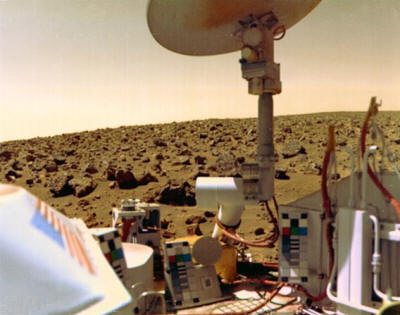|

by Michael E. Salla, Ph.D.
April 14, 2012.
from
Exopolitics Website

View of Mars
taken by the Viking Mission in 1976
A team of scientists and mathematicians
analyzing data from the
1976 Viking Mission have concluded that life
on Mars was detected in one of the four experiments conducted by the
two robotic landers.
Their report, “Complexity
Analysis of The Viking Labeled Release Experiments,”
released last week in the International Journal of Aeronautical and
Space Sciences has resurrected a controversy over the results of the
Viking Mission’s “Labeled Released experiment” designed by Dr
Gilbert Levin.
The Viking mission was the only Mars
mission so far that was designed by NASA to detect life.
Dr Levin was confident that the
experiment had detected microbial life on Mars, but his NASA
colleagues disagreed and his startling finding was forgotten in the
Martian sands of time. This new scientific investigation has
concluded that Levin was right all along.
Wikipedia summarizes NASA’s official position on the “Labeled
Released experiment” and the position taken by Levin’s colleagues
back in 1976:
In the [Labeled Release] LR
experiment, a sample of Martian soil was inoculated with a drop
of very dilute aqueous nutrient solution.
The nutrients (7 molecules that were
Miller-Urey products) were tagged with radioactive 14C. The air
above the soil was monitored for the evolution of radioactive
14CO2 gas as evidence that microorganisms in the soil
had metabolized one or more of the nutrients…
The result was quite a surprise
following the negative results of the first two tests, with a
steady stream of radioactive gases being given off by the soil
immediately following the first injection. The experiment was
done by both Viking probes the first using a sample from the
surface exposed to sunlight and the second probe taking the
sample from underneath a rock both initial injections came back
positive.
Subsequent injections a week later
did not, however, elicit the same reaction, and the result
remains inconclusive.
Here is how Irene Klotz from Discovery
News
described the novel approach taken by scientists in the newly
released report:
Researchers crunched raw data
collected during runs of the Labeled Release experiment, which
looked for signs of microbial metabolism in soil samples scooped
up and processed by the two Viking landers.
General consensus of scientists has
been that the experiment found geological, not biological,
activity.
The new study took a different approach. Researchers distilled
the Viking Labeled Release data, provided as hard copies by the
original researchers, into sets of numbers and analyzed the
results for complexity. Since living systems are more
complicated than non-biological processes, the idea was to look
at the experiment results from a purely numerical perspective.
They found close correlations
between the Viking experiment results' complexity and those of
terrestrial biological data sets. They say the high degree of
order is more characteristic of biological, rather than purely
physical processes.
The team of scientists are very
conclusive in
their 2012 report:
The only extraterrestrial life
detection experiments ever conducted were the three which were
components of the 1976 Viking Mission to Mars. Of these, only
the Labeled Release experiment obtained a clearly positive
response… We have applied complexity analysis to the Viking LR
data...
We conclude that the complexity
pattern seen in active experiments strongly suggests biology
while the different pattern in the control responses is more
likely to be non-biological… These analyses support the
interpretation that the Viking LR experiment did detect extant
microbial life on Mars.
One of the scientists, Dr Joseph
Miller a neuropharmacologist and biologist with the University
of Southern California Keck School of Medicine, was interviewed by
Discovery News and
said:
"On the basis of what we've done so
far, I'd say I'm 99 percent sure there's life there."
So are the results from this new
scientific investigation of the Viking data conclusive, was life
discovered on Mars?
A 99 % degree of certainty is very high, and
while critics might argue is not conclusive, it would at the very
least, have required follow up life detection experiments by NASA
over the last three decades. NASA however has not designed such
experiments ever since the 1976 Viking Mission. Why not?
According to NASA critic,
Richard Hoagland, author of
Dark Mission - NASA Secret History,
NASA is not interested in discovering whether life exists or has
existed on Mars. Such a discovery would be too disturbing for human
civilization as we know it, as starkly revealed in the
1961 NASA
Brookings Report presented to the US Congress that Hoagland helped
bring to public attention back in 1993.
NASA’s real mission appears to be one of
merely justifying funding for future space missions that do nothing
to disturb the scientific consensus that we are alone in the
universe. NASA data pointing to evidence of life in our solar system
is systematically ignored, censored or simply disappears. Scientists
challenging this policy are silenced, discredited, and/or fired.
NASA’s next robotic mission,
Mars
Science Laboratory (aka Curiosity) again does not have any life
detection experiments on board. It’s hard not to disagree with
Hoagland’s conclusion that NASA’s real mission is a dark one after
all - don’t do anything to prove that life exists elsewhere in our
solar system.
Thankfully, more and more scientists do
not agree, as reevaluation of the 1976 Viking Mission data clearly
shows.
|

